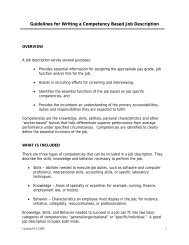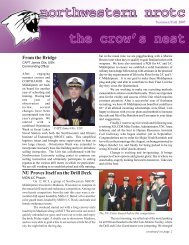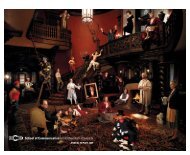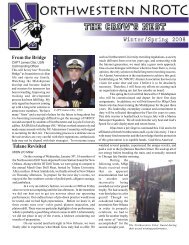Artistry Permits and Custom May Ordain - Northwestern University
Artistry Permits and Custom May Ordain - Northwestern University
Artistry Permits and Custom May Ordain - Northwestern University
You also want an ePaper? Increase the reach of your titles
YUMPU automatically turns print PDFs into web optimized ePapers that Google loves.
207 Ibid.<br />
208 G. de San Bernadino, Itinerario. in SD, 157.<br />
44<br />
Reportedly, in 1498, Malindi’s sultan “was seated on two cushioned chairs of bronze;” 207<br />
almost a century later the sultan held state meetings <strong>and</strong> “sat in a skillfully wrought chair<br />
of mother-of-pearl.” 208 This latter chair design was very similar to the kiti cha enzi, or<br />
“chair of power,” of the nineteenth century. The chair’s ornately carved frame, inset with<br />
ivory or mother-of-pearl, connoted its occupant’s access to channels of wealth production<br />
<strong>and</strong> the employment of high-wage skilled artisans. These chairs are remembered as serving<br />
in Siyu as the ruler’s “throne” at baraza, or town meetings. 209 While the office of sultan<br />
had been liquidated in most Swahili city-states by the mid 1800s, the kiti cha enzi is still<br />
reserved only for those with significant resources. 210 Such chairs in the sixteenth century<br />
were designed to exalt the position of the sultan(a) <strong>and</strong> to humble petitioners entering<br />
the sultan(a)’s court. Sultan Yusuf of Sofala received guests while seated on an Indian<br />
couch covered with silk cloths, while all visitors—even the wealthiest merchants of the<br />
town—sat on “low triangular three-legged stools, the seats of which were of undressed<br />
hide.” 211<br />
Large ivory horns, or siwa, were for the exclusive use of the sultan(a) <strong>and</strong> his/her<br />
lineage, as documented on numerous occasions in accounts of Swahili courts. 212 These<br />
horns embodied state power, <strong>and</strong> numerous oral traditions from Kilwa, Vumba, <strong>and</strong> Pate<br />
attest to their importance in public functions. The Sultan of Malindi in the late fifteenth<br />
century was always preceded by “many players of anafils [metal horns] 213 <strong>and</strong> two<br />
trumpets of ivory, richly carved, <strong>and</strong> of the size of a man, which were blown from a hole in<br />
209 H. Brown, “Siyu: Town of Craftsmen,” 108. (Brown’s oral history was given by Husein Omari, 1981.) Brown<br />
notes that the chairs are still used during wedding ceremonies. This seems very similar to the use of umbrellas<br />
<strong>and</strong> chairs in the weddings of Shirazi families of Domoni. Personal Communication, M. Ottenheimer, 1996. cf.<br />
idem, Marriage in Domoni.<br />
210 See J. de Vere Allen, “The Kiti Cha Enzi <strong>and</strong> Other Swahili Chairs,” African Arts. (22) 3 (1989): 54-63; <strong>and</strong><br />
“Swahili Culture Reconsidered,” 118.<br />
211 Castanheda, 387.<br />
212 Similar siwa which still exist are made out of bronze, wood, as well as a combination of ivory <strong>and</strong> bronze. H.<br />
Sassoon, The Siwas of Lamu: Two Historic Trumpets in Brass <strong>and</strong> Ivory. Nairobi, 1975, <strong>and</strong> J. de Vere Allen, “The<br />
Siwas of Pate <strong>and</strong> Lamu: Two Antique Side-Blown Horns from the Swahili Coast,” Art <strong>and</strong> Archeology Research<br />
Papers. (1976): 38-47. cf. A. Dickenson, “The Regalia of the Wa-Vumba,” Man. (21) 1921. 33-5. It is also worthy<br />
of note that side-blown ivory horns are not unique to the Swahili coast. Items of similar form <strong>and</strong> function can<br />
be found throughout the East African interior. J. de Vere Allen, “Two Antique Ivory Musical Instruments from<br />
Central Kenya,” Kenya Past <strong>and</strong> Present. 8 (1977): 11-13.<br />
213 Short <strong>and</strong> thin metal horns were still called fili on Ngazija in the early twentieth century. Fontoynont <strong>and</strong><br />
Rom<strong>and</strong>ahy, “La Gr<strong>and</strong>e Comore,” Mémoires de l’Académie Malgache. (23) 1937. Pl. XII. It is also possible that<br />
the anafils described by Portuguese observers are similar to the modern zumari, or short horns of metal, ivory, or<br />
wood. See A. Boyd, “The Musical Instruments of Lamu,” Kenya Past <strong>and</strong> Present. 80 (1977): 5-6.














